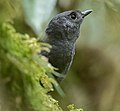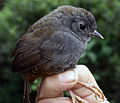Biology:Scytalopus
| Scytalopus | |
|---|---|

| |
| Magellanic tapaculo (Scytalopus magellanicus) | |
| Scientific classification | |
| Domain: | Eukaryota |
| Kingdom: | Animalia |
| Phylum: | Chordata |
| Class: | Aves |
| Order: | Passeriformes |
| Family: | Rhinocryptidae |
| Genus: | Scytalopus Gould, 1837 |
| Type species | |
| Motacilla magellanica Magellanic tapaculo Gmelin, JF, 1789
| |
| Species | |
|
49 species, see list | |
Scytalopus is a genus of small suboscine passerine birds belonging to the tapaculo family Rhinocryptidae. They are found in South and Central America from Tierra del Fuego to Costa Rica, but are absent from the Amazon Basin. They inhabit dense vegetation at or near ground-level and are mainly found in mountainous regions, particularly the Andes. They can be very difficult to see as they run through the undergrowth in a mouse-like fashion.
Description
They are plump with short tails that often are held cocked. Depending on species, the total length is 10–14 cm (4-5½ in). Their plumage is blackish or grey. Several species have brown bellies, rumps or flanks; often with some barring. A few have white crowns or eyebrows. Juveniles of most species are browner and have barred flanks. Many species are essentially impossible to separate by their plumage, but songs and calls are often distinctive and important for species identification.
Behavior
Their diet consists mainly of insects. Little is known about the breeding habits of most species but the eggs are usually white and the nest is usually ball-shaped and made of plant material such as root-fibres and mosses. It is built in a cavity in sites such as earth banks or among the roots or bark of trees.
Taxonomy
The genus Scytalopus was introduced in 1837 by the English ornithologist John Gould.[1] The name combines the Ancient Greek skutalē or skutalon meaning "stick" with pous meaning "foot".[2] The type species was specified in 1840 by George Robert Gray as the Magellanic tapaculo.[3]
The species-limits within this genus is among the most complex matters in Neotropical ornithology. They are highly cryptic, and identification using visual features often is impossible. Vocal and biochemical data is typically needed to clarify the taxonomic status of the various populations. Several new species have been described in recent years (e.g. S. stilesi and S. rodriguezi from Colombia). The taxonomic status of many of the Andean species was resolved by Krabbe & Schulenberg (1997) who split a number of species and described three new ones. The confusing situation is perhaps best illustrated by the fact that only 10 species were recognized in this genus in 1970 (Krabbe & Schulenberg, 2003), while the figure now is more than four times as high. Additionally, still undescribed species are known to exist, while some species as currently defined actually may include several species (e.g. the southern population of the large-footed tapaculo may represent an undescribed species). Donegan & Avendano recently reviewed the Colombian and Venezuelan species, formally describing one new subspecies and providing details of a further three undescribed species or subspecies to be described in future publications.
The Brazilian taxa are similarly complex with several recently described species and considerable confusion surrounding the use of the scientific name Scytalopus speluncae.
Conservation
Some species have highly localized distributions, and being poor fliers, they easily become isolated in small populations. BirdLife International currently (2007) consider one species vulnerable (Scytalopus panamensis) and three species endangered (S. iraiensis, S. rodriguezi and S. robbinsi).
Species list
The genus contains 49 species. The white-breasted and Bahia tapaculos were formerly placed in this genus, but these two species are now known to be closer to the bristlefronts (genus Merulaxis) and have therefore been moved to Eleoscytalopus.[4]
| Image | Common Name | Scientific name | Distribution |
|---|---|---|---|
| Marsh tapaculo or wetland tapaculo | Scytalopus iraiensis | Brazil. | |
 |
Diamantina tapaculo | Scytalopus diamantinensis | Brazil (Bahia) |
 |
Brasília tapaculo | Scytalopus novacapitalis | Brazil (Goiás, the Distrito Federal, and western Minas Gerais.) |
 |
Rock tapaculo | Scytalopus petrophilus | Brazil (Rio de Janeiro and São Paulo) |
 |
Planalto tapaculo | Scytalopus pachecoi | southeastern Brazil and extreme northeastern Argentina. |
 |
Blackish tapaculo | Scytalopus latrans | Colombia, Ecuador, Peru, and Venezuela. |
 |
Mouse-coloured tapaculo | Scytalopus speluncae | Brazil (Espírito Santo to northeastern Rio Grande do Sul.) |
| Dusky tapaculo | Scytalopus fuscus | Chile. | |
 |
Magellanic tapaculo | Scytalopus magellanicus | Chile (Tierra del Fuego as far as Valparaíso Region), Argentina ( San Juan Province) |
 |
Ancash tapaculo | Scytalopus affinis | Peru. |
| White-winged tapaculo | Scytalopus krabbei | Peru | |
 |
Loja tapaculo | Scytalopus androstictus | Ecuador (Zamora-Chinchipe Province), Peru( Department of Cajamarca) |
 |
Paramo tapaculo | Scytalopus opacus | southern Colombia to south-central Ecuador |
| Paramillo tapaculo | Scytalopus canus | Colombia. | |
 |
White-browed tapaculo | Scytalopus superciliaris | northwestern Argentina |
 |
Zimmer's tapaculo | Scytalopus zimmeri | Bolivia and Argentina |
 |
Puna tapaculo | Scytalopus simonsi | Bolivia and Peru |
 |
Diademed tapaculo | Scytalopus schulenbergi | Bolivia and Peru. |
 |
Vilcabamba tapaculo | Scytalopus urubambae | Peru |
| Ampay tapaculo | Scytalopus whitneyi | Peru. | |
 |
Jalca tapaculo | Scytalopus frankeae | Peru. |
 |
Neblina tapaculo | Scytalopus altirostris | northern Peru |
 |
Trilling tapaculo | Scytalopus parvirostris | Bolivia and Peru. |
| Bolivian tapaculo | Scytalopus bolivianus | Bolivia and Peru. | |
| White-crowned tapaculo | Scytalopus atratus | Bolivia, Colombia, Ecuador, Peru, and Venezuela. | |
| Santa Marta tapaculo | Scytalopus sanctaemartae | Colombia (Sierra Nevada de Santa Marta) | |
 |
Long-tailed tapaculo | Scytalopus micropterus | Colombia, Ecuador and far northern Peru |
| Rufous-vented tapaculo | Scytalopus femoralis | Peru | |
| Utcubamba tapaculo | Scytalopus intermedius | Peru. | |
| Large-footed tapaculo | Scytalopus macropus | Peru. | |
 |
Junin tapaculo | Scytalopus gettyae | Peru. |
| Unicolored tapaculo | Scytalopus unicolor | Peru. | |
 |
Tschudi's tapaculo | Scytalopus acutirostris | Peru. |
| Bahian mouse-colored tapaculo or Boa Nova tapaculo | Scytalopus gonzagai | Brazil(Bahia) | |
 |
Silvery-fronted tapaculo | Scytalopus argentifrons | Costa Rica and Panama. |
 |
Nariño tapaculo | Scytalopus vicinior | Colombia and Ecuador. |
| Tacarcuna tapaculo or pale-throated tapaculo | Scytalopus panamensis | Panama and Colombia | |
 |
Chocó tapaculo | Scytalopus chocoensis | Colombia, Ecuador, and Panama. |
| Magdalena tapaculo | Scytalopus rodriguezi | Colombia | |
| Stiles's tapaculo | Scytalopus stilesi | Colombia | |
 |
Tatama tapaculo | Scytalopus alvarezlopezi | Colombia |
| El Oro tapaculo or Ecuadorian tapaculo | Scytalopus robbinsi | south-western Ecuador | |
| Caracas tapaculo | Scytalopus caracae | Venezuela. | |
 |
Pale-bellied tapaculo | Scytalopus griseicollis | Colombia and Venezuela |
 |
Brown-rumped tapaculo | Scytalopus latebricola | Colombia |
 |
Perijá tapaculo | Scytalopus perijanus | Colombia, Venezuela |
| Mérida tapaculo | Scytalopus meridanus | Venezuela. | |
 |
Chusquea tapaculo | Scytalopus parkeri | southern Ecuador and far northern Peru. |
| Spillmann's tapaculo | Scytalopus spillmanni | Colombia and Ecuador. |
References
- ↑ Gould, John (1837). "Genus Scytalopus". Proceedings of the Zoological Society of London Part 4 (46): 89. https://www.biodiversitylibrary.org/page/30570816. Although the volume bears the date of 1836, the issue was not published until 1837.
- ↑ Jobling, James A. (2010). The Helm Dictionary of Scientific Bird Names. London: Christopher Helm. p. 352. ISBN 978-1-4081-2501-4.
- ↑ Gray, George Robert (1840). A List of the Genera of Birds : with an Indication of the Typical Species of Each Genus. London: R. and J.E. Taylor. p. 19. https://www.biodiversitylibrary.org/page/13668913.
- ↑ Gill, Frank; Donsker, David; Rasmussen, Pamela, eds (July 2021). "Antthrushes, antpittas, gnateaters, tapaculos, crescentchests". IOC World Bird List Version 11.2. International Ornithologists' Union. https://www.worldbirdnames.org/bow/antthrushes/. Retrieved 28 July 2021.
- Donegan, Thomas & Avendano, Jorge E. (2008): Notes on Tapaculos (Passeriformes: Rhinocryptidae) of the Eastern Andes of Colombia and Venezuelan Andes, with a new subspecies of Scytalopus griseicollis from Colombia. Ornitologia Colombiana 6. 24-65 PDF fulltext
- Greeney, Harold F. & Gelis, Rudolphe A. (2005) The nest and nestlings of the Long-tailed Tapaculo (Scytalopus micropterus) in Ecuador, Ornitología Colombiana 3:88-91. Accessed 18/06/07.
- Maurício, Giovanni Nachtigall (2005) Taxonomy of new populations in the Scytalopus speluncae group, with description of a new species and remarks on the systematics and biogeography of the complex (Passeriformes: Rhinocryptidae), Ararajuba 13 (1):7-28. Accessed 18/05/07.
- Maurício, N. M, Matta, H., Bornschein, M. R., Cadena, C. D., Alvarenga, H., & Bonatto, S. L. (2008) Hidden generic diversity in Neotropical birds: Molecular and anatomical data support a new genus for the “Scytalopus” indigoticus species-group (Aves: Rhinocryptidae). Molecular Phylogenetics and Evolution. 49(1): 125–135.
- Raposo, Marcos A.; Stopiglia, Renata; Loskot, Vladimir & Kirwan, Guy M. (2006) The correct use of the name Scytalopus speluncae (Ménétriés, 1835), and the description of a new species of Brazilian tapaculo (Aves: Passeriformes: Rhinocryptidae), Zootaxa 1271: 37–56. Accessed 18/06/07.
- South American Classification Committee (2007) A classification of the bird species of South America, part 7. Accessed 18/06/07.
- Comitê Brasileiro de Registros Ornitológicos: List of Birds in Brazil
- Avedaño, Jorge E., Cuervo, A., López-O., J. P., Gutiérrez-Pinto, N., Cortés-Diago, A. & Cadena, C. D. (2015): A new species of tapaculo (Rhinocryptidae: Scytalopus) from the Serranía de Perijá of Colombia and Venezuela, The Auk Volume 132, 2015, pp. 450–466.
Wikidata ☰ Q386521 entry
 |

